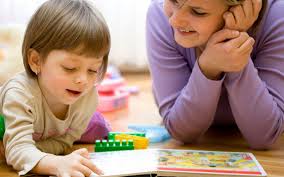Last updated on September 30th, 2021 at 10:18 am
 As moms of multiples, we see firsthand how not all children learn the same way, and that when it comes to teaching and learning, one size definitely does not fit all. So, what is a twin mom to do? Here are some tips on helping your little learners blossom in their own, unique way!
As moms of multiples, we see firsthand how not all children learn the same way, and that when it comes to teaching and learning, one size definitely does not fit all. So, what is a twin mom to do? Here are some tips on helping your little learners blossom in their own, unique way!
As parents, we learn over and over again that children that are raised in the same home, by the same parents and in the same manner can end up being as different as black and white. This, of course, can go for all spectrums of life, including learning.
There are so many ways to learn and technology is breeding more ways each and every day. Some children absorb books like a sponge; some are visual learners, and some need motion to associate ideas and concepts. Music can stimulate certain children, while others are very personal and learn best while being taught.
What do you do when you have one child that learns slightly, or even drastically, different from another, and you are responsible for teaching them both every life skill and basic lesson before Kindergarten or even beyond? First, take a deep breath and second, do what every parent learns to do… invent today and if it doesn’t work you can re-invent it tomorrow.
Now, inventing the day isn’t a matter of winging it Pippy-Longstocking-style, but rather about taking a combination of needs into consideration. What triggers your child’s interests? What distracts them? When is a good time for them and how do they take praise and criticism? What works for the family and for you?
 I cannot emphasize the last question enough because a family is a network of individuals living life and learning together. One of the great lessons to teach our children is the art of compromise and adjusting. Sometimes plans change and what was good for one day’s schedule will not be for another. Implanting flexibility is beneficial to everyone’s future. So, what does this mean?
I cannot emphasize the last question enough because a family is a network of individuals living life and learning together. One of the great lessons to teach our children is the art of compromise and adjusting. Sometimes plans change and what was good for one day’s schedule will not be for another. Implanting flexibility is beneficial to everyone’s future. So, what does this mean?
You might have separate work spaces or work times with each child. This opens a door to more one-on-one time if needed, especially during those early years. This will also make learning a positive time when your child is able to spend time with just you. You and your spouse can even separate the children’s responsibilities and then regroup afterwards to see where praise and emphasis need to be.
With many children when they are trying to learn, especially at home, it can be difficult because of the mass draw of distractions. If you have a perfectionist child who likes to do everything themselves and a sibling blurts an answer, you could have an unwanted sibling war on your hands. Beneath the screams then rests a child who feels like they are unworthy. Contrary to that, many times multiples can work as a team. You may have a child that is strong in one area and answers for the both of them leaving the other one at a disadvantage to learning that skill for themselves. Together they embody a complete educational package, but separately the needs are illuminated (many times surprising the parents).
 Then there is the easily distracted child who is busy thinking about the purple dog three pages ago and how it would look in a green collar. These children work better alone in order to focus their attentions toward whatever task is being mastered and may need more persistent focus reminders. This can get frustrating to the child already thinking about the next page. Though working apart can be ideal in many cases, working together can be, as well. At some point in the real world, your child is most likely going to be surrounded by people and it is important to teach them how to work in a class or group setting. You will have to coax the timid learners and hold back the aggressive ones while fostering love, praise and guidance toward both. Have each child teach a lesson so that the material is reinforced for them and taught through another perspective. This is a special time for them and shows that it is alright to learn from a sibling and that they have a lot to offer. The skills necessary to appreciate and accept help from others besides you is a gift not only to them, but to you, as well.
Then there is the easily distracted child who is busy thinking about the purple dog three pages ago and how it would look in a green collar. These children work better alone in order to focus their attentions toward whatever task is being mastered and may need more persistent focus reminders. This can get frustrating to the child already thinking about the next page. Though working apart can be ideal in many cases, working together can be, as well. At some point in the real world, your child is most likely going to be surrounded by people and it is important to teach them how to work in a class or group setting. You will have to coax the timid learners and hold back the aggressive ones while fostering love, praise and guidance toward both. Have each child teach a lesson so that the material is reinforced for them and taught through another perspective. This is a special time for them and shows that it is alright to learn from a sibling and that they have a lot to offer. The skills necessary to appreciate and accept help from others besides you is a gift not only to them, but to you, as well.
When the books and lessons are put away for the day, just always remember not to compare your children. Their brains are made differently and their thoughts are different. Praise them for efforts and not accomplishments and show them the things they can work on in a positive light. Always have a next step for them to work on, even when they have mastered the lesson for that day. Not only will this give them something to work towards, but if you have a child who is more behind than the other it gives them a sense of security in knowing that everyone has a next step. Paint the picture of the life-long learner. There is no end game to learning and even we, as parents, learn every day.
In the world of children, and especially multiples, it is always important to maintain individuality and learning is no exception. Their interests, goals, and endeavors will follow a certain path created by their imagination, internal world, and external experiences. Walk the path with each child and see what possibilities lie ahead.
Nellie Harden has been married for 12 years and is a mom of four little girls, who represent four corners of a square and bring different gifts, energy and challenges to their world. In addition to being a mom, she works with families through JuicePlus to get enough fruits and vegetables into growing and changing bodies every day and enjoy writing about all of life’s avenues.






